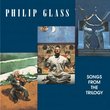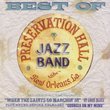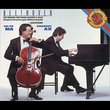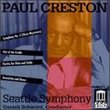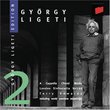| All Artists: Robert [Composer] Simpson, Vernon Handley, Royal Philharmonic Orchestra Title: Robert Simpson: Symphony No. 1; Symphony No. 8 Members Wishing: 0 Total Copies: 1 Label: Hyperion UK Release Date: 12/17/1996 Album Type: Import Genre: Classical Style: Symphonies Number of Discs: 1 SwapaCD Credits: 1 UPC: 034571168906 |
Search - Robert [Composer] Simpson, Vernon Handley, Royal Philharmonic Orchestra :: Robert Simpson: Symphony No. 1; Symphony No. 8
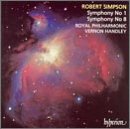 | Robert [Composer] Simpson, Vernon Handley, Royal Philharmonic Orchestra Robert Simpson: Symphony No. 1; Symphony No. 8 Genre: Classical
![header=[] body=[This CD is available to be requested as disc only.]](/images/attributes/disc.png?v=15401716) ![header=[] body=[This CD is available to be requested with the disc and back insert.]](/images/attributes/disc_back.png?v=15401716) ![header=[] body=[This CD is available to be requested with the disc and front insert.]](/images/attributes/disc_front.png?v=15401716) ![header=[] body=[This CD is available to be requested with the disc, front and back inserts.]](/images/attributes/disc_front_back.png?v=15401716) |
Larger Image |
CD DetailsSimilarly Requested CDs
|
CD ReviewsSimpson's music is not for the musically lazy or fat, but it Allen N. Gilfert | Kentucky | 08/06/2005 (5 out of 5 stars) "In a world full of liars, who tells the truth? In my opinion (which I will not lie about), the music of Simpson is very original, and can be very moving if the listener knows what to look for in its contents. I believe Simpson's work is rooted in the masters of music (bearing relations to Bach, Beethoven, and Bruckner - to name a few), but has its own unique and individual voice. The previous reviewer's response, being word for word exactly the same as posted for another Simpson recording, is a complete misunderstanding of what Simpson is accomplishing in his music. Simpson is not concerned with melody in the same sense as any other composer: he is concerned with how melody should be written by Robert Simpson, not what I or another might be concerned about. It is his own path, and while I may not agree with every moment of his musical argument, I find I have a lot in common, musically speaking, with what he is telling melodically. I find melodies in his symphonies that become memorable with repeated listening (especially the chorale-prelude theme in Symphony No. 9). It is more akin to late Sibelius or Nielsen, where melodies are present, most assuredly, but more importantly there is a striving for something beyond memorable melody (more tied to polyphony); therefore, I believe it is more about reaching a compactness of form, and that there is a concentrated effort of growing the musical material to reach the highest possible peak before ending. This music's almost constant movement, matched with a few moments of a static quality, is highly original, and I would advise anyone with a willing mind to give Simpson several tries, and not only one attempt." Symphonies of integrity by a man of integrity Rodney Gavin Bullock | Winchester, Hampshire Angleterre | 12/26/2001 (5 out of 5 stars) "Robert Simpson, who died a few years ago, was a wonderful man with a mordant wit and no-nonsense approach to music. A memorial book of reminiscences published by the Robert Simpson Society revealed how much he was loved by those he came into contact with, enriching their lives with his humour, erudition and absolute integrity. He worked as a producer for the BBC's Radio 3 where he was often in artistic conflict with his superiors. Simpson was a keen amateur astronomer and his interest in the cosmos is to be felt in some of his later works, as did a fascination with the growth of the embryo. Haydn, Beethoven, Bruckner and Nielson were his musical gods and he wrote books on the latter two. He is best known for his symphonies and string quartets. His music is tonal throughout (he rejected serialism) but there is often a high level of dissonance. The influence of Nielsen can be heard initially but later the sound world is totally his own. There are often long stretches of extremely busy, fast, complex music followed by slow, almost static passages. A lot of it is a challenge to the listener Like his friend, Edmund Rubbra, the processes of the musical arguments do not lend themselves to shimmering orchestral colours.The First Symphony (1951) is his first published work in this genre. Rubbra, reviewing the symphony, wrote, '...this is a remarkable work, not only as a First symphony but as a symphony'. The work is a continuous structure but divides into three distinct parts, moderato, slow, fast It is impossible to describe briefly but has a bleak, granitic quality. On this CD, each 'movement' is indexed into four or five sections. Some refer to key landmarks in the score and this is very helpful in getting your bearings but others appear to be redundant. I will just say it is a marvellous work.The 8th symphony (1981) was conceived when Simpson thought how the old composers, like Haydn, knew exactly for whom they were writing - the modern composer '... cannot often say to himself as he works, "I can just see old So-and-So's face when this bit hits him!"'. So Matthew Taylor quotes Simpson in his excellent notes and goes on to write how Simpson asked a friend to tell him what sort of symphony he would like him to compose. The result was the massive 8th symphony, formidably difficult to play and requiring a huge orchestra. The symphony is in two parts: poco animato + scherzo, then adagio + finale (presto). All begins sweetly, with a piccolo motif and this mood continues for some time. Gradually the music grows more threatening, with angry interjections from the timpani, including the snare drum, bringing to mind Nielsen's 5th symphony. The music suddenly subsides into quiet but not calm. Nasty things are abroad. The woodwinds sound as though they are fleeing something dreadful. All Hell is let loose and the movement closes quietly with the throb of the lower strings. The adagio begins with an anguished melody on the strings. This material is interrupted several times by very quiet episodes, variously scored and of considerable beauty. Each is brutally ended but they get longer each time. The last runs into the finale which is an orchestral tour de force and full of energy. The work ends abruptly with four sharp chords.The playing of the Royal Philharmonic under Vernon Handley is exemplary and the recording first rate. Hyperion are to be congratulated on recording all Simpson's symphonies and quartets, as well as much else." The symphony is not dead! Geoffrey Brock | London United Kingdom | 01/10/2001 (5 out of 5 stars) "Many composers of the 20th century (especially its first half) seem to feel that the symphonic form was exhausted, if not dead, and that tonality was a thing of the past. As a result, much "modern" music can be difficult to approach. Throughout his life, Robert Simpson chose to explore the possibilities of classical forms, and showed that they still had much to offer. Furthermore, he wrote in a clear, diatonic style that is immediately approachable. His music is often described as "muscular", and indeed it is rugged and forceful.The first symphony, written in 1951, is in one continuous movement, but in three sections: moderato-slow-fast. It is a powerful and energetic piece, and Handley and the RPO show a commitment and understanding of the work which will many new listeners will find persuasive.The eighth symphony (1981) is in two parts, but as each is in two sections, it falls broadly into the traditional four movement form: fast-scherzo-adagio-finale. It has tremendous energy and vitality which carries the listener along. Again, the playing is excellent.The recording of both works is extremely good, and the disc is a valuable addition to anyone's collection."
|

 Track Listings (16) - Disc #1
Track Listings (16) - Disc #1


